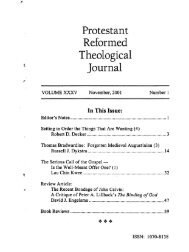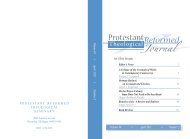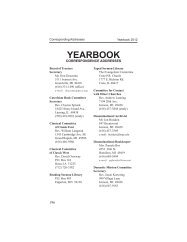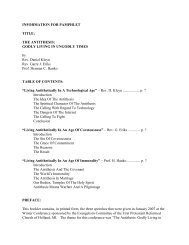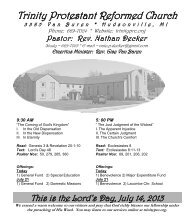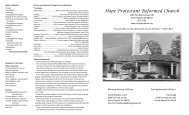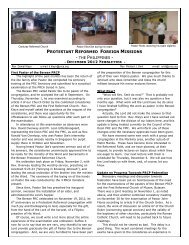November 2007 - Protestant Reformed Churches in America
November 2007 - Protestant Reformed Churches in America
November 2007 - Protestant Reformed Churches in America
Create successful ePaper yourself
Turn your PDF publications into a flip-book with our unique Google optimized e-Paper software.
Book Reviews<br />
eral of Witsius’ works, <strong>in</strong>clud<strong>in</strong>g<br />
his Practical Theology and own judgment regard<strong>in</strong>g the<br />
The reader is left to make his<br />
Grondstukken, which, literally movement.<br />
translated, would be Groundpieces.<br />
various men forcibly under-<br />
Read<strong>in</strong>g the writ<strong>in</strong>gs of the<br />
The last five of these men scores the great positive characteristic<br />
of the <strong>Reformed</strong> pi-<br />
lived <strong>in</strong> the seventeenth century<br />
and were representative figures etistic movement—its <strong>in</strong>sistence<br />
that the faith by which we<br />
of the Further Reformation (also<br />
known as Dutch Pietism, or are justified is a faith that also<br />
nadere reformatie). De Reuver sanctifies, so that the Christian<br />
sets out to demonstrate the <strong>in</strong>fluence<br />
that Clairvaux (twelfth that he is a child of God.<br />
must manifest <strong>in</strong> all of his life<br />
century) and à Kempis (fifteenth<br />
century) had upon them: Reuver seems sensitive to the<br />
Throughout the book, de<br />
“The ma<strong>in</strong> question that plays charge that pietism led to a mystical<br />
emphasis on feel<strong>in</strong>gs apart<br />
an explicit role <strong>in</strong> this study is<br />
that of the cont<strong>in</strong>uity or discont<strong>in</strong>uity<br />
of the Further Refor-<br />
repeatedly asserts that the mys-<br />
from the Word of God, for he<br />
mation’s spirituality with that of ticism of these men was proper.<br />
the Middle Ages” (p. 19). The Of Teell<strong>in</strong>ck’s mysticism he<br />
conclusion is drawn that the piety<br />
of the Further Reformation not give rise to faith, but one<br />
says, “It is a mysticism that does<br />
“has <strong>in</strong> common with Bernard’s which spr<strong>in</strong>gs from faith and is<br />
mysticism … the strong emphasis<br />
on emotional love <strong>in</strong> the ex-<br />
De Reuver defends Theodorus<br />
always tied to faith” (p. 160).<br />
perience of communion with à Brakel specifically regard<strong>in</strong>g<br />
God” (p. 281), and has <strong>in</strong> common<br />
with à Kempis “a medita-<br />
brand of mysticism strives for a<br />
the question of “whether this<br />
tive devotional attitude” (p. k<strong>in</strong>d of contemplation that m<strong>in</strong>imizes<br />
the Word and faith” (p.<br />
282).<br />
Although De Reuver spends 197). Of the five Further Reformation<br />
pietists, he says:<br />
three pages <strong>in</strong>troduc<strong>in</strong>g the Further<br />
Reformation (16-18), he “Without exception they all promote<br />
a spirituality <strong>in</strong> which the<br />
offers no critical evaluation of<br />
it. He acknowledges his own heart experiences communion<br />
sympathy for it, be<strong>in</strong>g a product<br />
of a pietistic environment. and Spirit” (p. 281). Yet, <strong>in</strong><br />
with God created by the word<br />
<strong>November</strong> <strong>2007</strong> 99



